Visits: 81
生物動力曆法﹕2018 年 8 月 21 日下午 7 時開始 – 果
十年前開始喝 Dettori,沒喝懂,因爲我把他當 Grenache 來喝。
沒過幾年,又開一瓶,還是沒喝懂,因爲我把他當天然酒來喝。
遇上了天堂莊,我才像慧能一樣,開始我遲來的頓悟:葡萄品種與人爲的法則不過是名相,本來無一物,唯有 Naturale。
終於鼓起勇氣,辦一場 Sardinia 撒丁島。
撒丁島我沒去過。西西里我也沒去過,但看過教父電影,這個意大利人稱之爲 Mezzogiorno 的「晌午」之地并不陌生。撒丁島其實離意大利本土更近,可是更像蠻荒之地。
Bastianich and Lynch 在 Vino Italiano 寫撒丁島的一章開始得令人驚心動魄:
Before we caught the ferry to Olbia, more than one person said: Get a good map, go slow and don't get lost. There are certain parts of Sardinia, most notably the Barbagia in the island's mountainous center, that are not only short on street signs but are apparently crawling with criminals. Some are illegal immigrants from Albania looking for a place to hide — and the hills of the Barbagia are as remote as it gets. Others are kidnappers who take people to the hills and hold them for a ransom.
到了島上,果然警察很多。他對兩大島的比較很有意思:
Of Italy's two Mediterranean isles, Sicily fits more seamlessly into the Italian whole. Sardinia has an aloofness that betrays its distance not only from the mainland (about eight hours on the express ferry, regardless of the jumping-off point) but also from its southern Mediterranean neighbor. Although Sardinia and Sicily both have an other-worldly feel, Sardinia feels less like an Italian region with exotic ethnic touches, and more like an ethnicity unto itself. The wines that crop up in the island’s boulder-strewn soils often have a similarly indefinable, incomparable quality.
「落後」地區往往朝兩極發展,有人從「先進」地區買了趕上現代號列車的票,另一些人卻死抱傳統不放,昔日的 Barolo 是這樣,今天的撒丁島也如此:Argiolas 與 Santadi 請來了調教出 Sassicaia 的 Giacomo Tachis 當顧問,但 Alessandro Dettori與 Gianfranco Manca(Panevino 酒莊)仍然我行我素。
今天,讓我們一起經歷這段正在發生的歷史。
是晚酒單如下:
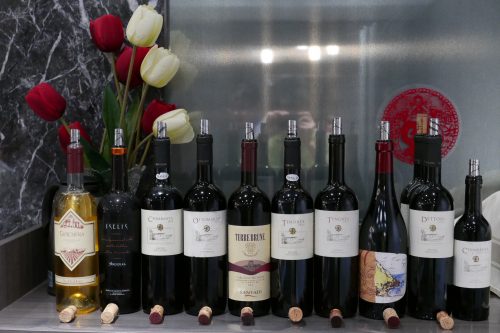
|
White (Vermentino) |
(Bianco) Capichera, Vermentino Classico, 2012 |
|
Monica |
1. Argiolas, Iselis Monica Sardegna, 2013 |
|
Monica |
2. Dettori, Chimbanta, 2013 |
|
Pascale |
3. Dettori, Ottomarzo, 2005 |
|
Carignano |
4. Santadi, Terre Brune, 2005 |
|
Cannonau |
5. Dettori, Tenores, 2012 |
|
Cannonau |
6. Dettori, Tenores, 2000 |
|
Cannonau |
7. Panevino, Isola dei Nuraghi Picci Rosso, 2014 |
|
Cannonau |
8. Dettori, Dettori Rosso, 2005 |
|
Monica |
(Sweet) Dettori, Chimbanta e Battoro, 2007 |
前三款紅酒在半天前開瓶,其餘的在一天前開,之後拔塞作瓶醒。
開場的白酒 Capichera, Vermentino Classico, 2012 在開始前三小時開瓶。
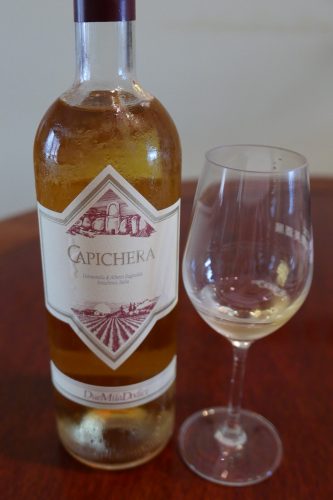 酒莊來自島的東北部 Gallura 地區,這裏產的白酒最好,而自從 1970 年代 Ragnedda 兄弟接手老酒莊以來,Capichera 便成爲 Vermentino 的復興功臣,Ian d’Agata 認爲他們的 Vermentino 是全意大利最好的。
酒莊來自島的東北部 Gallura 地區,這裏產的白酒最好,而自從 1970 年代 Ragnedda 兄弟接手老酒莊以來,Capichera 便成爲 Vermentino 的復興功臣,Ian d’Agata 認爲他們的 Vermentino 是全意大利最好的。
第一回合有類似枇杷果和檸檬皮的香氣,甜如蜜餞果,但酸度不錯。第二回合更完全綻放,有黃花香,仍然有檸檬皮,變得圓潤了,甜、酸與苦味同時出現,而且有很好的勁度,彷佛感受到島上常吹著的大風。
第一次喝撒丁島的 Vermentino,跟 Tuscany 的很不一樣,與其他白酒也不同,充滿了異國風情,就如上面引文說的:an ethnicity unto itself。
Piedmont 的日常飲用酒是 Dolcetto 與 Barbera,這裏是 Monica。這兩款酒相對簡單,所以我在半天前開瓶。
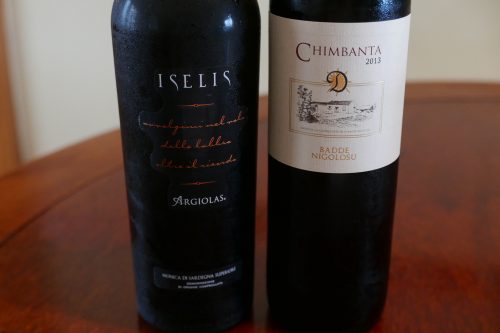 1. Argiolas, Iselis Monica Sardegna, 2013 的桶香與果香在打架,口感蠻豐富的,有果也有帶鹹的礦物味,凌厲的丹寧也讓酒增添了結構感。很多新派的 Barbera 用小桶來添加香氣與結構,因此也拿到高分數,這款 Monica 看來用了同樣的策略,這是為國際口味調教出來的,很有 Giacomo Tachis 的影子。酒莊年產兩百萬瓶。
1. Argiolas, Iselis Monica Sardegna, 2013 的桶香與果香在打架,口感蠻豐富的,有果也有帶鹹的礦物味,凌厲的丹寧也讓酒增添了結構感。很多新派的 Barbera 用小桶來添加香氣與結構,因此也拿到高分數,這款 Monica 看來用了同樣的策略,這是為國際口味調教出來的,很有 Giacomo Tachis 的影子。酒莊年產兩百萬瓶。
與此相比,2. Dettori, Chimbanta, 2013 顯然土氣十足,但土得可愛。Chimbanta 是土話,五十的意思,是莊主獻給爸爸 Paolo 五十嵗生日的禮物,希望他長命百歲。早上小試有野花野草,充滿大自然氣息,第一回合香氣更複雜:水泥、野花、野草和野果,早上清香,現在濃烈了,但仍然通透,圓滑,有鹹與苦味作襯托,一點都沒有日常用酒的果汁感覺。
大家一致認爲土酒更好。
到了第二回合,1. Argiolas, Iselis Monica Sardegna, 2013 的桶味更厲害了,我懷疑木桶帶來的丹寧令口感變得更粗獷。
2. Dettori, Chimbanta, 2013 這時變得更豐滿,花香、石灰、黑土并出,但依然圓融,在口裏鋪開了一張厚厚的毯子似的,喝得舒服。
仍然由五十嵗拿了全票。這是我喝過最好的日常飲用酒之一,凴大家興奮的神情,我懷疑這是我們一致的意見。
但我要提醒大家這款酒像很多天然酒一樣,一瓶與另一瓶可能有差異,一位去過酒莊的朋友更告訴我不同年份的差異更大得很。
大家看看他的酒窖是這樣的。
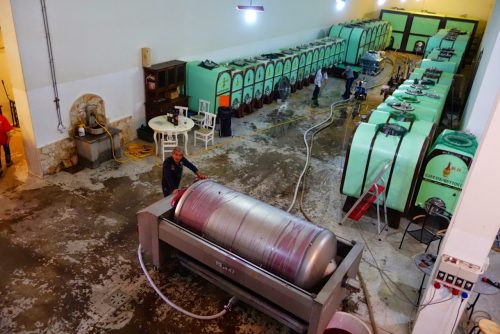 取自: http://notdrinkingpoison.blogspot.com/2015/04/tenute-dettori-alessandro-sardinia.html
取自: http://notdrinkingpoison.blogspot.com/2015/04/tenute-dettori-alessandro-sardinia.html
酒莊採用完全不干預政策,奉行生物動力法,除了在灌瓶時非必要時才會加硫磺,完全不用木桶,只用爺爺留下來的水泥缸。他們的酒一般酒精度很高,常達到 15、16 度,酒液常會渾濁,有時候在瓶内會再發酵。
Alssandrano Dettori 在他們的網站有此宣言,他們的酒可以叫動物酒:
If being a Homo sapiens sapiens means looking but not observing, eating but not tasting, hearing but not listening, smelling but not enjoying a scent… well then, I am proud to be a Homo sapiens sapiens and nothing more.
I feel myself an animal just like the other animals. Part of planet earth and of the universe. I want to be an animal with that minimum of rationality necessary for my free will. That is why I make wine… it is the method I know for making me feel what I am: instinctually an animal.
這樣説來,我們今天很幸運,這款 2013 Chimbanta 十二分出色。
接著我們試另外兩種葡萄。
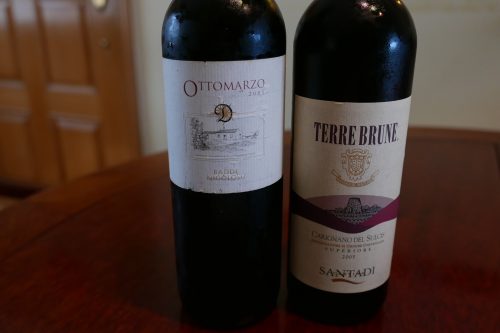
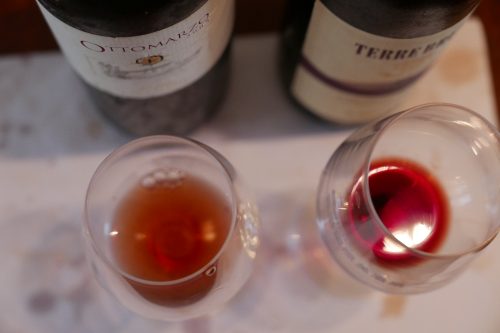 3. Dettori, Ottomarzo, 2005 用的是島上也少見的 Pascale。Ottomarzo 是三月八日的意思,是爺爺的生日。酒色非常淺,聞起來有點揮發性酸度(Volatile acidity),蠻像某些鉛華盡去的老年份 Barolo,入口甜而順滑,什麽都羽化了,很好喝。
3. Dettori, Ottomarzo, 2005 用的是島上也少見的 Pascale。Ottomarzo 是三月八日的意思,是爺爺的生日。酒色非常淺,聞起來有點揮發性酸度(Volatile acidity),蠻像某些鉛華盡去的老年份 Barolo,入口甜而順滑,什麽都羽化了,很好喝。
第二回合竟然更甜,而且又甜又甘,而且還更稠密。剛才覺得有點空洞,現在充實了一點。
Ian d'Agata 高度贊許這款酒,但今天我們只能凴想像了。
我的想像回到三年前。一天,我開了另一瓶 2005 給一群國内朋友嘗新,那瓶很正常,意思是有種不修邊幅的粗獷風味,令其中一位着了迷,後來他親自去了酒莊一趟,並拿下國内的代理權。
另一款 4. Santadi, Terre Brune, 2005 用的是 Carignano 品種,酒莊是個合作社,位於西南端的 Sulcis 半島,曾受 Giacomo Tachis 指導,Ian d'Agata 認爲他們是全意大利最好的兩三家合作社之一。Carignano 在這一帶種得最好,Terre Brune(棕土地)是他們兩款旗艦酒之一,混了 5% 的 Bovaleddu,老籐長在原來的樹根(ungrafted rootstock),在新的法國小木桶陳年 16-18 個月。
很濃烈,體型龐大,但丹寧被豐滿的果包裹得很好,令人驚訝的是那麽濃烈的酒體竟然很通透和優雅,唯一可挑剔的是有點燒焦的氣味,那應該是木桶帶來的,但我懷疑這種葡萄不用小木桶來馴服也不行。
第二回合一切都好,只是桶味更突出了。
第一回合由 ”老 Barolo” 贏了 9:1,第二回合全勝。
接著兩雙是今天的戯肉,由 Cannonau 擔綱演出。
一般看法是這品種其實是法國的 Grenache,在西班牙叫 Garnacha,在 Tuscany 則叫 Alicante,可能是西班牙人統治的時候傳進來的。不過 Alessandro Dettori 有自己的看法,他引歷史文獻說 Cannonau 在 1549 年已在撒丁島出現,比西班牙早了足足兩個世紀。
但我們更關心的是這品種在撒丁島有什麽風土表現。
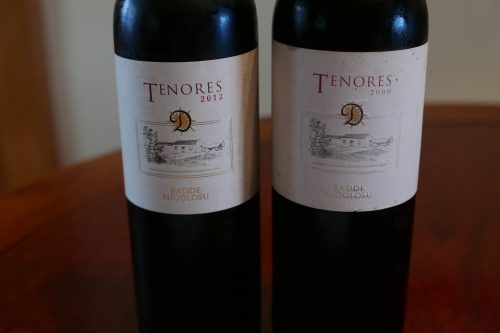 第一雙名叫 Tenores,字面是男高音的意思,原來這是兩塊田的混釀,這兩塊田在一條小路的兩邊,但一個溫柔,另一雄渾,混在一起就如二人對歌一樣。酒莊的説法是:“The singing in Tenores in Sardinia is powerful and overwhelming, but at the same time sweet and harmonious, precisely like our wine. It is the expression of the area's forcefulness and elegance.”
第一雙名叫 Tenores,字面是男高音的意思,原來這是兩塊田的混釀,這兩塊田在一條小路的兩邊,但一個溫柔,另一雄渾,混在一起就如二人對歌一樣。酒莊的説法是:“The singing in Tenores in Sardinia is powerful and overwhelming, but at the same time sweet and harmonious, precisely like our wine. It is the expression of the area's forcefulness and elegance.”
兩款酒差異甚大,首先 2012 的顔色是閃亮的寶石紅,2000 卻淺但透亮。
2012 在早上小試時主要是各種的野外草本植物,有些如燒烤的野香草;晚上卻盛放野花和粉香,有種令人血液沸騰的 youthful exuberance,丹寧如脫繮野馬。青春在燃燒!我也年輕過!
2000 早上有點類似氧化的氣味,但通透,甜得入心入肺,晚上有種不吃人間烟火的無比的輕,細如絲輕如絲的丹寧游走在舌尖,一點點烟草,一點點橙皮,正忙著嗅他,他卻突然從高空掉下,變得有點平板,然後果味出來了。我在撒丁島看了日出?
我打賭主流酒評人一定給 2012 高分數,而 2000 必然說是有毛病的酒。但我們竟然以 9:1 大比數認爲 6. Dettori, Tenores, 2000 好很多!
第二回合的 2012 變得圓潤了,幾乎可說性感,那粉香和脂粉味很迷人,有人說有幾分像 Barolo 的 Freisa。
那邊廂 2000 好像又升上天空,翺翔在無限寬廣的天宇之間,稀薄但通透,但又不是完全無重的狀態,因爲入口可以感覺到一種張力,有種柔若絲的肌理。佛家講的完滿具足是這種狀態嗎?
想不到闊別多年,我被 Dettori 完全征服了。想來 Cannonau 應該源自太陰,寄居於極炎熱至乾旱的撒丁島,那裏充滿陽氣,這陰陽相交,便成萬物,應了老子所言:
道生一,一生二,二生三,三生萬物。萬物負陰而抱陽,沖氣以爲和。
試過上面的 2013 Chimhanta 和 2012 Tenores,我感覺他們似乎與 2005 Ottomarzo 和現在這款 2000 Tenores 很不一樣,幾乎像兩個不同酒莊的出品。我懷疑那是成人畫與兒童畫的差別。
Robert Camuto 在 2005 年曾訪問 Dettori,他寫得太好了,請容忍我在這裏把他的前半篇原文照錄於下:
A decade ago, Alessandro Dettori was a young, crazy winemaker making wild, unpredictable wines on his family's farm at the northwestern tip of Sardinia, off Italy's western coast.
Dettori made surprisingly big reds from what's considered an easy-drinking grape, Monica, and some tamer wines from Cannonau (the local name for Grenache) which typically makes full-bodied inky reds on this Mediterranean island.
They were exciting, often confusing wines—the vinous equivalent of an artist hurling paint at canvas. When you opened a bottle, you quickly understood that they were made by a talented winemaker who definitely had an edge.
Today at 39, Dettori has mellowed. And so have his wines.
"You can live your life in peace or at war," Dettori says, trying to explain his evolution as a winemaker. "I realized I was at war."
Dettori's head is still topped by dark curls, and he often still speaks about wine with messianic urgency. But nowadays he breathes between sentences. He is wearing a jacket and button-down shirt, relaxing after a day pouring his wines at the spring Vinitaly wine fair in Verona.
Dettori grew up on his family's farm atop a panoramic sea-view bluff worthy of a five-star resort; now his parents run a B&B and agriturismo restaurant there. Dettori's father, Paolo, a man with a chiseled face who is as granitic as his son is ethereal, was a shepherd who later opened a wine shop in Alghero. Dettori's grandfather tended the vineyards and made wines that were sold in demijohns (large 5- to 15-gallon jugs known as carboys in the U.S.) to locals and restaurants.
"I never understood how my grandfather made such perfect wine," says Dettori, who worked with his grandfather starting at the age of 12. "He never wanted to bottle wine. To him, wine was something to be drunk without all this ceremony."
Dettori left the farm to study economics and sow his wild oats in the wider world. He was living in Brazil for a brief period in 1998 when he learned his grandfather had died, and he rushed back to Sardinia.
"I needed to make wine because I was the only one who worked with my grandfather," he says. "It was my time."
Dettori took over nearly 148 acres of vineyards, which he eventually culled to 111. After considering international varieties, he set out to duplicate his grandfather's white Vermentinos, as well as reds from Cannonau, Monica (a grape of uncertain origin widely grown in Sardinia) and Pascale (a local grape more often used for blending).
Dettori worked in his grandfather's cellar, with his 60 small cement tanks used for both fermenting and long aging. He farmed organically, as his grandfather had, didn't filter the wines and added little or no sulfites.
Dettori first showed his wines at Vinitaly in 2000. They were ripe and powerful with alcohol levels upward of 17 percent, and they quickly found a niche following internationally. But he remained unsatisfied.
"They were good wines, but they were chaotic," Dettori says. "Like my life."
Dettori says it took marrying and becoming a father at the end of the decade for him and his wines to settle down. "I finally made the same wine as my grandfather in 2010," he says. "When I tasted it, I cried."
(來自:http://www.winespectator.com/blogs/show/id/51580)
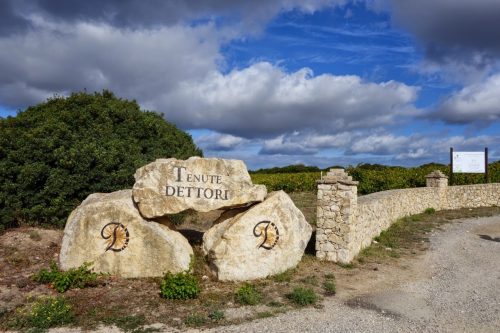
取自: http://notdrinkingpoison.blogspot.com/2015/04/tenute-dettori-alessandro-sardinia.html
Alessandro 在 1998 年囘鄉繼承爺爺的衣鉢,他沒有經驗,只凴他的動物本性來作畫(見上面討論 2. Dettori, Chimbanta, 2013 時的引文),當時他的作品如 Jackson Pollock 那樣 — “They were exciting, often confusing wines—the vinous equivalent of an artist hurling paint at canvas.”
十年後(2010 年),他終於釀出記憶中爺爺當年完美的酒,開心得讓他掉淚。
但讓我掉淚的卻是他早期的作品,即今晚喝得到的 2000 和 2005。
讓我這麽說:新的兩款是我們熟悉的好酒,你念 WSET,你看主流的酒評,便知道這些是高分酒;2005 與 2000 卻很域外,他們的美令我們目瞪口呆,因爲以前沒有經驗過,我們甚至不肯定這是不是美。Sergio Esposito 曾以 unjustifiable beauty 來形容這種體驗,Matt Kramer 喝過 Frank Cornelissen 早期的 Magma 也開始重新思考何爲偉大的酒.
我的中國文化恩師吳美雲離世前出了一本講特異功能的書,她天才的領悟出一個道理來:很多小孩都有所謂的特異功能,可是受了正規教育以後,原來四通八達的網絡有部分因爲不再使用便堵塞了,所以失去了這些功能,因此仍然保留這種功能的極少數才稱之爲特異。
因此我跟 Alessandro 不一樣,他的 2012 和 2013 令我感動,但 他的 2000 和 2005 如有特異功能一樣,令我掉淚。
我懷疑 Etna 的 Frank Cornelissen 也經歷了這個過程。他早期的作品令你不知所措,最近的酒似乎更符合我們習慣的美感觀念。Ian d'Agata 一年前便如此稱贊他:
His winemaking has changed over the years, moving from the production of highly “natural-like” wines that spoke more of the technique employed (and ironically enough not much about the specific terroirs) to wines that are now truly magnificent (some of Italy's most interesting red wines, in fact).
最後我們試兩款老樹 Cannonau。
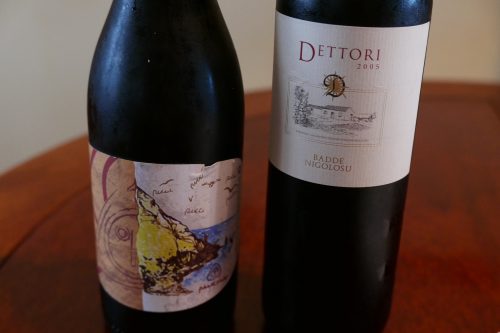
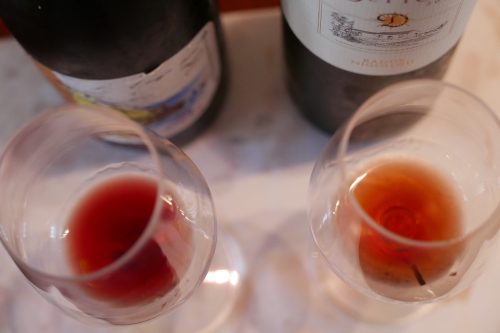 7. Panevino, Isola dei Nuraghi Picci Rosso, 2014 是麵包師傅 Gianfranco Manca 的作品,酒莊名字是麵包與酒兩個字的複合詞,他當初想把他發酵麵包的多年經驗用於葡萄,試驗品是他屋前已多年棄耕的老籐。他不停的試驗,每年的酒款都不一樣,但用今天的尺度都屬於天然酒。
7. Panevino, Isola dei Nuraghi Picci Rosso, 2014 是麵包師傅 Gianfranco Manca 的作品,酒莊名字是麵包與酒兩個字的複合詞,他當初想把他發酵麵包的多年經驗用於葡萄,試驗品是他屋前已多年棄耕的老籐。他不停的試驗,每年的酒款都不一樣,但用今天的尺度都屬於天然酒。
早上小試時,有水泥與野果,晚上更開放,有點像上面 Dettori 的 Chimbanta 與 Ottomarzo,很野,而且有很明顯的鹹味。
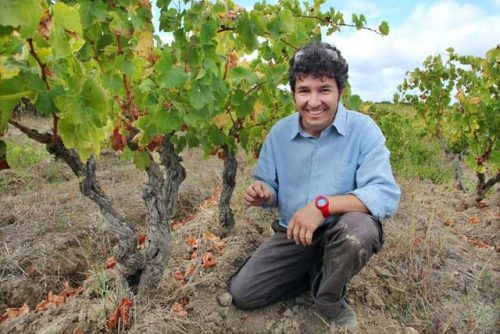 130 嵗的老籐,照片來自:http://www.wineterroirs.com/2014/10/dettori_tenute_sardinia_italy.html
130 嵗的老籐,照片來自:http://www.wineterroirs.com/2014/10/dettori_tenute_sardinia_italy.html
8. Dettori, Dettori Rosso, 2005 來自酒莊最老的籐,部分達到 130 嵗,他的香氣令人不知所措,有點像頭一次試 Burlotto 的 Monvigliero 那樣,是種很野,很域外的香氣,大概比 Burlotto 的清純,更多花香,也有帶鹹的礦物味,收結甚長。
大家正在陶醉的時候,我拿了只剩下 1/5 的另一瓶 8. Dettori, Dettori Rosso, 2005 來讓大家試。
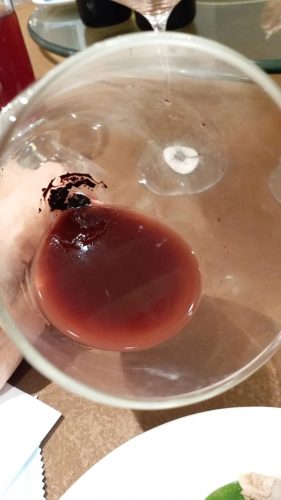 這是我 20 個月前(2016 年 12 月)開的酒,喝了兩個星期仍然有很香的花露水、香粉、香水但同時又有些像藥水甚至天那水的奇怪味道。一個半月後,一群國内的隨意朋友來香港到我家裏坐,我從冰箱拿出這瓶放了兩個月的酒讓他們試,大家都驚訝的發現酒蠻好喝的,一點氧化的跡象都沒有,有一位還説 Chateau Rayas 就是這種味道。
這是我 20 個月前(2016 年 12 月)開的酒,喝了兩個星期仍然有很香的花露水、香粉、香水但同時又有些像藥水甚至天那水的奇怪味道。一個半月後,一群國内的隨意朋友來香港到我家裏坐,我從冰箱拿出這瓶放了兩個月的酒讓他們試,大家都驚訝的發現酒蠻好喝的,一點氧化的跡象都沒有,有一位還説 Chateau Rayas 就是這種味道。
又過了18 個月,今天大家一下杯,幾乎下巴也掉了下來!他竟然噴出濃若杏仁霜的香氣,最令人嘖嘖稱奇的是一點慣常的氧化氣味都沒有,而且還帶著花香!加上酸度極好,所以非常活潑!
第二回合的 7. Panevino, Isola dei Nuraghi Picci Rosso, 2014 更豐滿,有很好的結構感;8. Dettori, Dettori Rosso, 2005 終於與 Burlotto 分道揚鑣,礦物味比較豐富,一種想像中的火山灰,極有勁度。
兩者比較,Panevino 外向,有力量,豐滿;Dettori 的力量是内聚的,通透,優雅。
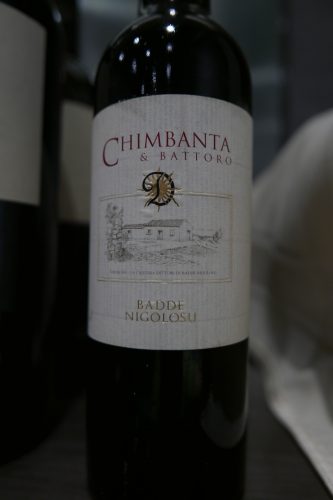 當天的尾聲是用風乾 Monica 葡萄釀造的甜酒 Dettori, Chimbanta e Battoro, 2007 ,與當晚的順德薑撞奶是絕配 — 甜而不膩,帶石灰氣味,有結構,有酸度。
當天的尾聲是用風乾 Monica 葡萄釀造的甜酒 Dettori, Chimbanta e Battoro, 2007 ,與當晚的順德薑撞奶是絕配 — 甜而不膩,帶石灰氣味,有結構,有酸度。
這晚順德菜吃得開心,Dettori 喝得感動,兩者似乎都深得 Naturale 的精妙。
Wine of the Night
這是另一場充滿 emozione 的隨意行活動。
8. Dettori, Dettori Rosso, 2005 以 22 分成為了大家的至愛。
第二名是有無可言狀之美的 6. Dettori, Tenores, 2000,得 15 分。
第三名是 2. Dettori, Chimbanta, 2013 與 3. Dettori, Ottomarzo, 2005,分別得 8 分與 7 分。